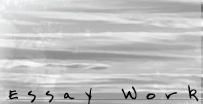
|
|
Seeing the Unseeable:
Poetry as a Bridge between Readers and Writers Poetry has maintained its nature as a coveted form of language, removed from other styles of writing, because of the unique ways in which it functions. A successful poem is an interactive dialogue between the writer and the reader, and thus can be meaningful on many different levels, as it combines the experiences and perceptions of both parties. This interaction is achieved in the utilization of literary devices, such as tone, mood and imagery, which can transfer the reader into the very consciousness of the poet at the time the poem was written, and translate the unseeable abstractions of a poem into ideas that are more tangible. In Maxine Kumin’s poem, Flying, many of the most important pieces of information within the work remain unsaid, or unseeable, and therefore abstract. The poem, which describes sexual abuse transcending generations of a family, never names the abuser directly. Instead, the poet embeds the identity of this abuser in the tone of the poem. This tone, though it shifts slightly from stanza to stanza, is one of isolated distance. “Every night your soul flies/ out of your body and into/God’s lap…Hearing this as a child haunted me./I couldn’t help sleeping” Such a removed tone compels the reader to wonder what is not being said and why such things have been omitted. Thus the removed sense of tone inspires interaction between poet and reader. In this specific poem, one can infer that Kumin is leaving out the details of the speaker’s abuser to show not only the pattern of abuse across generations, but also to leave room for the reader to further connect to the poem. Establishing a strong tone of distance transports the reader to the same level, but by not pinpointing the details of the conflict the poet allows the reader to take that level further and fill in the blanks of the poems with ideas that stem from their own lives. Other poets achieve this interaction between reader and writer
through the mood of their poem, and the implications of this mood
open the poem to the reader’s deduction. In On the Screened
Porch by Elizabeth Biller Chapman, the mood opens the forum for
dialogue between writer and reader. The poem is written in the voice
of a woman enjoying a meal on the porch of her childhood home, still
inhabited by her mother, fifty years later. The poem is a celebration
of obstacles overcome, as it is evident the family was once less
perfect than they appear to be now. The reflective and almost prideful
mood of the poem is teased with wistful hints at a sorrowful time:
“The garden not as it was, but lush, intensely green, the
lawn’s near perfect.” The words “not as it was”
contradict the otherwise upbeat mood of the poem, and prompt the
reader to imagine the garden at a time where it served a contrast
to its current well kept state. In addition to tone and mood, imagery can serve as the literary
bridge between reader and writer. In Sam Hamill’s Natural
History, the poet describes one day of work with his daughter as
an explanation for his feeling suspended between his father and
daughter. The vivid depictions of the day’s activities lead
up to abstractions that the reader can fill in.
The imagery preceding the potential abstraction allows the reader
to explore the “answer to some old incessant question”
that would be otherwise inaccessible. The imagery serves as a visual
then, on which the reader can balance layers of meaning, to turn
the unseeable pieces of the poem to a tangible reality for the reader.
|